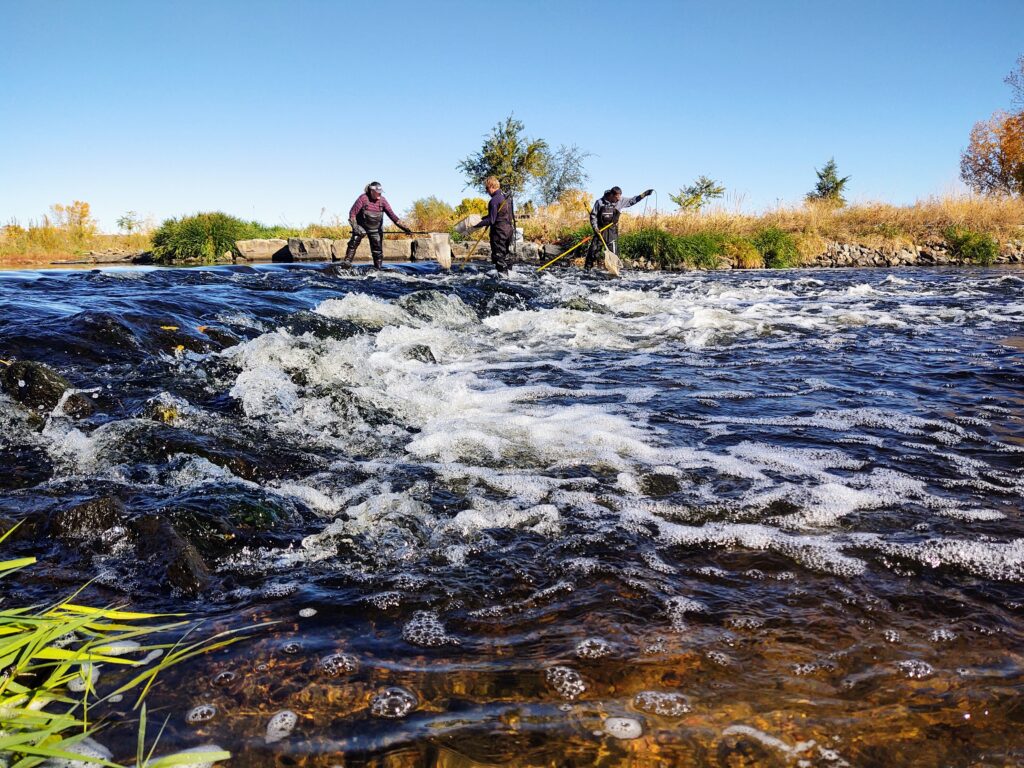Water Quality Division Wraps Up 2022 Electrofishing Surveys




Since the early 1970’s, Metro Water Recovery has monitored the water quality of the South Platte River. Every fall, Metro’s Water Quality Division conducts field surveys and bio-assessments to determine how Metro’s discharge impacts and affects the river’s aquatic environments. The collection of fish data via electrofishing provides the backbone of aquatic life assessment along the South Platte River downstream of Denver. Electrofishing is a common method of fishing used by fisheries biologists that means just what it sounds like: using electricity to catch fish. Metro Water Quality Scientists shock the fish, making them easier to catch without the use of hooks, lines or other methods that could cause harm or injury. Stunned fish can then be easily scooped up in a net and placed in a temporary holding tank where they can revive and be observed for data collection. Biologists use this method of electrofishing to determine:
- Abundance
- Density
- Species Composition
- age distribution
- Presence of invasive species
Finalized in November 2022, the results for 2022 season involved ten separate surveys along the South Platte River from 31st Avenue in Denver to Fort Lupton. This year, staff collected 7,971 individual fish, comprised of 18 different species.
South Platte River Fish Survey: 2022 Summary
| Scientific Name | Common Name | Distribution | Count |
| Pimephales promelas | Fathead Minnow | Native | 3077 |
| Gambusia affinis | Western Mosquitofish | Introduced | 1306 |
| Rhinichthys cataractae | Longnose Dace | Native | 1173 |
| Notropis stramineus | Sand Shiner | Native | 1168 |
| Catostomus commersoni | White Sucker | Native | 871 |
| Etheostoma exile | Iowa Darter | Native | 100 |
| Cyprinus carpio | Common Carp | Introduced | 72 |
| Lepomis cyanellus | Green Sunfish | Native | 67 |
| Micropterus salmoides | Largemouth Bass | Introduced | 35 |
| Etheostoma nigrum | Johnny Darter | Native | 33 |
| Semotilus atromaculatus | Creek Chub | Native | 19 |
| Catostomus catostomus | Longnose Sucker | Native | 17 |
| Perca flavescens | Yellow Perch | Introduced | 9 |
| Culaea inconstans | Brook Stickleback | Native | 8 |
| Micropterus dolomieui | Smallmouth Bass | Introduced | 7 |
| Lepomis macrochirus | Bluegill | Introduced | 5 |
| Pomoxis nigromaculatus | Black Crappie | Introduced | 3 |
| Pomoxis annularis | White Crappie | Introduced | 1 |
Of all of these fish observed in 2022, 82% are native to this portion of the South Platte River. The most common native fish that we observed were small native minnows (Fathead Minnows, Sand Shiners, Longnose Dace) and White Suckers. A fish species is considered native to a given region or ecosystem if its presence in that region is the result of only natural processes, with no human intervention. In contrast, if a species is introduced by human activity (either intentionally or unintentionally), it is referred to as an introduced species within the region where it was anthropogenically introduced.
The most common introduced fish species in this portion of the South Platte River are also considered to be invasive: the Common Carp and the Western Mosquitofish. The Common Carp, native to Europe and Asia, was introduced to the United States in the late 1800s as a food source. They are highly prolific benthic foragers, and their presence has been linked to degraded water quality (increased turbidity, release of nutrients from sediment, etc.). The Western Mosquitofish was originally introduced for mosquito control, but they have become invasive and their presence has been linked to the decline or even extirpation of native fish species including the Northern Plains Killifish and Plains Topminnow.
These annual fish surveys provide valuable information about the aquatic life health of the South Platte River, but they are also labor-intensive. In addition to the hard work and commitment of the Water Quality Division staff, these surveys would not be possible without the help of a group of volunteers. This fall , 17 different volunteers helped make these surveys possible. Many thanks to those volunteers who didn’t hesitate to put on a pair of waders and jump in the river to lend a hand! To watch and learn more about Metro’s work to monitor and protect the South Platte River, check out our feature video here. For more in-depth information about Metro’s monitoring efforts, visit our monitoring page here.
